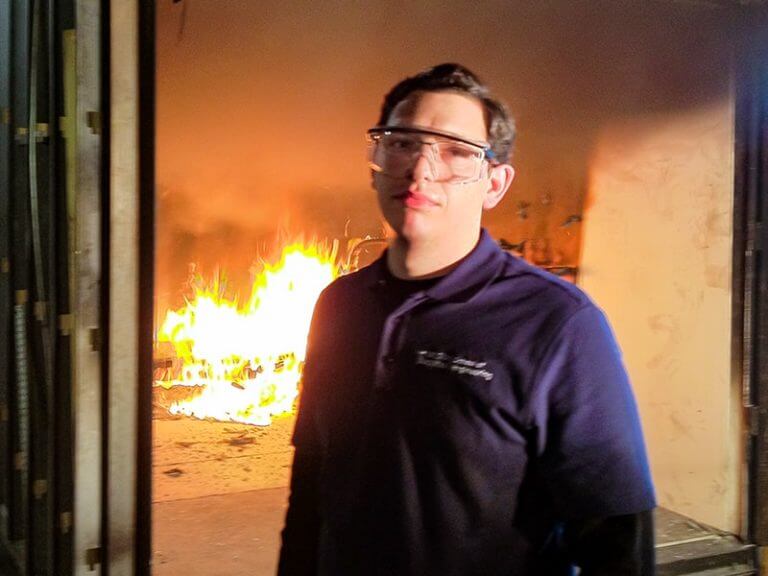- August 22, 2018
- By Chris Carroll
 If you think the wildfires turning swaths of California and elsewhere to ash this summer are a phenomenon confined to the American West, think again.
If you think the wildfires turning swaths of California and elsewhere to ash this summer are a phenomenon confined to the American West, think again.
“Even here, our air quality has been affected by the California wildfires,” says Michael J. Gollner, an associate professor of fire protection engineering whose research concentrates on wildland fires. Just last week, smoke from the California fires stretched over most of the Northeast, he says.
The Mendocino Complex Fire encompassing parts of three Northern California counties—the biggest in state history—had scorched nearly 400,000 acres as of this week. Nationwide, 109 large fires have burned nearly 2 million acres.
And of course, College Park itself can experience wildfires—a brushfire broke out off Metzerott Road in April—providing some of his students an opportunity to practice their wildland fire-fighting skills. Factors ranging from people’s housing choices to the efficiency of modern firefighting tactics to shifts in global climate have changed the fire landscape, Gollner said in a recent interview.
Are there more wildfires now, or are people just paying more attention?
If you look at a plot of the number of wildfires per year, you’ll see that it’s fairly flat over time. So there aren’t a lot more fires now than in the past, but if you consider the area burned over a running average, it’s drastically going up at least since 1985. There is more area burning, mostly because the number of extremely large fires is growing.
What’s driving the change?
One reason is that for the longest time, we’ve simply put out small fires. And so if you remove these small fires from the landscape, the fuels build up. But when extreme fire conditions develop with high winds, drought and all the excess fuel, then it becomes impossible to put out those fires.
Why not just let small fires burn and clear out all dead trees and other fuel?
That has to do with the second big reason: Increasingly, people are living out in areas they didn’t used to live—in what we call the wildland-urban interface, or WUI. This is where people are living next to natural forests, scrubland, chaparral. People don’t like fires near their homes, don’t like the smoke and so why not just put out all those fires? Also, when you live there, you don’t just experience fires, but you may be contributing to starting them accidentally. Electrical power lines can start fires, for example.
Is climate change supercharging the fires?
Climate is one of the big buzzwords here. I’m not a climate expert myself, but what is shown in the literature is that droughts are becoming more severe and longer, at least locally in the West. We’re also having more extreme fire danger days than in the past—hot, dry and windy—which is going to cause more extreme fires.
What can be done?
In terms of land management, we can try to provide less fuel in the landscape. So the key is prescribed or managed burning—we don’t like to call it “controlled burning,” which implies the fire is completely controlled and free of risk. So you have experts intentionally set fires in certain places on certain days when you know what the fire behavior is likely to be, or just let naturally set fires burn out in areas that need to clear fuels. You might go in before and clear some of the fuel so it will be a smaller fire.
What are some engineering solutions?
We can also protect our homes and communities, and engineer them to be more resilient against fires—for example, so they don’t ignite when little embers land on them. There’s been a lot of investigative work at a government lab we work with—the National Institute of Standards and Technologies here in Maryland—to make structures more resistant to these embers, or “firebrands,” which can be carried aloft over a wide area by the weather systems these big fires create. With their support we are making great advances in our research to understand how homes ignite and provide better risk-management tools to land managers.
Speaking of weather—what was that so-called “fire tornado” from California’s Carr fire that was on the news last week?
I’ve never seen anything like it before. There was an account of one that happened in Australia, and another from the [1923] Great Kanto earthquake in Japan outside Tokyo where around 40,000 people were killed. But to see it on video, and see the intensification that happened was simply incredible.
Tags
Research